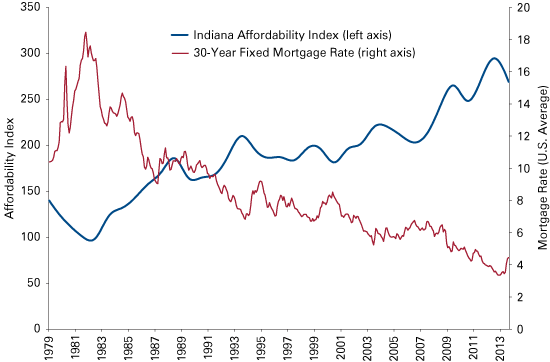Housing Market Outlook for 2014
State Demographer and Economic Analyst, Indiana Business Research Center, Kelley School of Business, Indiana University
The year 2013 has been the year of the housing rebound in Indiana and around the country. According to the National Association of Realtors, U.S. home sales during the first nine months of the year were up 12 percent over the same period in 2012. Here in Indiana, the number of houses sold through September 2013 improved by more than 17 percent year-over-year, and the state’s median sales price climbed 4.2 percent (see Table 1).
Table 1: Housing Metrics in Indiana, 2012 to 2013
| 2012 | 2013 | Percent Change | |
|---|---|---|---|
| Existing Home Sales | 49,883 | 58,558 | 17.4% |
| Median Sales Price | $118,000 | $122,900 | 4.2% |
| Residential Building Permits | 10,302 | 13,163 | 27.8% |
| Foreclosure Rate (3rd Quarter) | 4.5% | 3.2% | - |
Note: Figures for sales, prices and permits represent activity through September of each year.
Sources: Indiana Association of Realtors, U.S. Census Bureau, and Mortgage Bankers Association
Other measures of housing activity are improving, too. Building permits are up by nearly 28 percent through September 2013 and the state’s foreclosure rate has fallen significantly in the last year.
Unprecedented affordability conditions helped to spur the housing rebound, but the cost of homeownership will likely increase in 2014. Not only are house prices on the rise again, but mortgage rates are climbing too (see Figure 1).
Figure 1: Mortgage Interest Rates and Indiana Housing Affordability Index, January 1979 to August 2013

Note: An index value of 100 means that a state’s median household income is exactly enough to qualify for a mortgage on a median-priced home. Values above 100 indicate that the median income is more than enough to qualify. Indiana’s index value was 269 in August 2013, meaning that the state’s median household income was 269 percent of the income needed for a mortgage on the median-priced house. Monthly affordability values are interpolated from annual data. The 2013 index values are a forecast.
Source: Freddie Mac and Moody’s Economy.com According to Freddie Mac, the 30-year fixed mortgage rate jumped from 3.45 percent in in April 2013 to 4.19 percent by October. In their October forecasts, both the Mortgage Bankers Association and Freddie Mac predict the rate will climb above the 5 percent mark in the second half of 2014. By historic standards, however, housing in Indiana should remain affordable for some time.
Looking to 2014, we expect that Indiana’s home prices, residential construction activity and foreclosure situation will continue to improve. The outlook for existing home sales is less clear. As several recent media reports have highlighted, a handful of real estate investment groups purchased a large number of homes in some Indiana markets in 2013 with the intention of converting these properties into rentals.1 It seems unlikely that investor purchases will continue at the same pace in 2014. In the absence of investor activity, individual homeowners will have to pick up the slack but the drivers of housing demand—a strong labor market, migration and access to credit—still aren’t firing on all cylinders.
In general, though, given that most of the key housing indicators are finally pointed in the right direction, we have plenty of optimism for the Indiana housing market heading into 2014. As with any outlook, however, we must point to the need for an improved labor market in Indiana, which will boost the state’s household formation rate and help reverse the net out-migration trend of the past few years. These factors will bolster demand and further revive the still-sluggish residential construction industry. Once the foundation of the housing market is shored-up, we’ll know that this recovery is built to last.
Notes
- Jeff Swiatek, “Investor home-buying group increases Indianapolis-area holdings,” Indystar.com, November 8, 2013.
Also in this Issue…
- International Outlook for 2014
- U.S. Outlook for 2014
- Financial Outlook for 2014
- Housing Outlook for 2014
- Indiana's Outlook for 2014
- Indiana's Agricultural Outlook for 2014
- Seeking Escape Velocity—Job, Income and Productivity Forecasts
- Anderson Forecast 2014
- Bloomington Forecast 2014
- Columbus Forecast 2014
- Evansville Forecast 2014
- Fort Wayne Forecast 2014
- Gary Forecast 2014
- Indianapolis-Carmel Forecast 2014
- Lafayette Forecast 2014
- Louisville Forecast 2014
- Muncie Forecast 2014
- Richmond Forecast 2014
- South Bend and Elkhart Forecast 2014
- Terre Haute Forecast 2014




